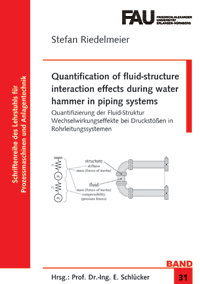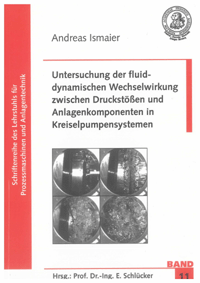Abstract
Mechanical loadings on pipe systems caused by water hammer belong to the most important and most difficult to calculate design loadings in pipes and can lead up to the rupture of the piping. By control procedures, on and shut-down processes, the sudden loss of pumps or unexpected operating conditions such substantial pressure fluctuations can occur in piping systems. Such loads have to be considered right from the planning and computation stage. These computations are especially important for plants with environmentally hazardous substances as they occur in the chemical industry and in nuclear power plants. Despite this fact even today the fluid dynamic interaction between water hammer and pipe systems is not completely understood. Therefore the aim of this thesis is to investigate fluid dynamic effects by the use of experimental and numerical methods: The behaviour of main components in a DN 100/PN 63 pipe system like centrifugal pump, pipe elbow and damping devices (resonator, pulsation damper and safety relief valves) is determined while a pressure wave is passing.
Centrifugal pumps generate in piping systems noticeable pressure pulsations with an amplitude up to 25% related to average pressure. Measurements indicated that pulsating centrifugal pumps can
damp pressure surges generated by fast valve closing. But not only damping effects are possible; also an amplification of the pressure amplitude can be observed. This can happen in case of a
self-excited oscillation between the pressure surge and an additional elasticity (in this case a moveable valve-disc). The energy source that drives the oscillation is the pump. Furthermore it is
presented that pressure surges pass centrifugal pumps almost unhindered, because they are hydraulically opened.
In literature pipe bends were also regarded as hydraulic open. But with the use of high-dynamic measuring technique (sampling rate up to 50 kHz) it could be proven that pipe bends reflect
pressure waves partially.
In order to keep the pressure amplitude, caused by inevitable pressure surges, as limited as possible, air vessels and pressure relief valves can be used in principle. However, both methods
require a careful design and positioning in the piping system, as a wrong appliance can also lead to an increase of the pressure surges.
All described phenomena can be simulated with 1-dimensional fluid codes. So it is possible to identify and avoid critical operating conditions.
English Article
The book is only available in German language. But an English article can be found in the magazin Nuclear Engineering and Design.
Bibliographic information:
A. Ismaier, E. Schlücker
Fluid dynamic interaction between water hammer and centrifugal pumps
Nuclear Engineering and Design, Volume 239, Issue 12, December 2009, Pages 3151–3154
Further information
Several information about the testing facility can also by found here:
Riedelmeier S. (2017): Quantification of fluid-structure interaction effects during water hammer in piping systems





